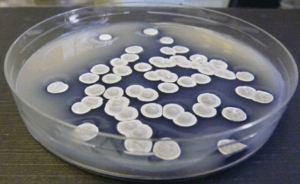SFM: Difference between revisions
No edit summary |
Sam Prudence (talk | contribs) |
||
| (10 intermediate revisions by 3 users not shown) | |||
| Line 1: | Line 1: | ||
= | =Mannitol Soya Flour (MS) a.k.a. Soya Flour Mannitol (SFM) Medium= | ||
[[File:Streptomyces.png | ''Streptomyces coelicolor'' growing on SFM agar | thumb]] | |||
Mannitol Soya Flour (MS) medium or as it is often called Soya Flour Mannitol (SFM)<sup>*</sup> medium, is a complex medium used for the routine cultivation of ''Streptomyces'' sp. Most species will sporulate well on this medium. | |||
<sup>*</sup>SFM became routinely used as an acronym for this media to avoid confusion with the plant growth medium Murashige & Skoog medium in the John Innes Media kitchen. | |||
==Preparation== | ==Preparation== | ||
Per Litre: | Per Litre: | ||
* | *20 g Mannitol | ||
* | *20 g Soya Flour | ||
* | *20 g Agar | ||
* | *1 L tap water | ||
'''Instructions''' | '''Instructions''' | ||
#Dissolve 20g mannitol in 1L tap water | #Dissolve 20g mannitol in 1L tap water | ||
#Add 2g | #Add 2g soya flour and 2g agar to each 250mL flask | ||
#Add 100mL mannitol solution to each flask | #Add 100mL mannitol solution to each flask | ||
#Autoclave | #Autoclave | ||
| Line 24: | Line 31: | ||
Soya flour is available from many health food shops and supermarkets (it is not necessary to purchase the more expensive material from a laboratory supplier). | Soya flour is available from many health food shops and supermarkets (it is not necessary to purchase the more expensive material from a laboratory supplier). | ||
Liquid | Liquid MS medium may be made by omitting the agar. | ||
Kieser et al (2000) recommend autoclaving | Kieser et al (2000) recommend autoclaving MS twice. Though this is not strictly necessary, the second autoclave cycle can help to break down some of the complex carbohydrates present in the soy flour, making them more readily available to the Streptomyces. Thus, you may observe improved growth and/or development when growing your strains on 2x autoclaved MS. | ||
[[Streptomyces venezuelae]] | ''[[Streptomyces venezuelae]]'' and ''[[Streptomyces clavuligerus]]'' do not sporulate well on MS medium. | ||
MS may also be used for bioassays, especially if supplemented with e.g. [[N-acetylglucosamine]] or [[sodium butyrate]] to elicit antibiotic production. | |||
==References== | ==References== | ||
Latest revision as of 15:23, 26 September 2019
Mannitol Soya Flour (MS) a.k.a. Soya Flour Mannitol (SFM) Medium
Mannitol Soya Flour (MS) medium or as it is often called Soya Flour Mannitol (SFM)* medium, is a complex medium used for the routine cultivation of Streptomyces sp. Most species will sporulate well on this medium.
*SFM became routinely used as an acronym for this media to avoid confusion with the plant growth medium Murashige & Skoog medium in the John Innes Media kitchen.
Preparation
Per Litre:
- 20 g Mannitol
- 20 g Soya Flour
- 20 g Agar
- 1 L tap water
Instructions
- Dissolve 20g mannitol in 1L tap water
- Add 2g soya flour and 2g agar to each 250mL flask
- Add 100mL mannitol solution to each flask
- Autoclave
Uses
- Routine growth of Streptomyces sp.
- Conjugations
- Preparing spore stocks
Notes
Soya flour is available from many health food shops and supermarkets (it is not necessary to purchase the more expensive material from a laboratory supplier).
Liquid MS medium may be made by omitting the agar.
Kieser et al (2000) recommend autoclaving MS twice. Though this is not strictly necessary, the second autoclave cycle can help to break down some of the complex carbohydrates present in the soy flour, making them more readily available to the Streptomyces. Thus, you may observe improved growth and/or development when growing your strains on 2x autoclaved MS.
Streptomyces venezuelae and Streptomyces clavuligerus do not sporulate well on MS medium.
MS may also be used for bioassays, especially if supplemented with e.g. N-acetylglucosamine or sodium butyrate to elicit antibiotic production.
References
Kieser, T., Bibb, M.J., Buttner, M.J., Chater, K.F. and Hopwood, D.A. (2000) Practical Streptomyces Genetics: John Innes Foundation, Norwich Research Park, Colney, Norwich NR4 7UH, UK
Hobbs, G, Frazer, CM, Gardner, DCJ, Cullum, JA & Oliver, SG 1989, 'Dispersed growth of Streptomyces in liquid culture', Applied microbiology and biotechnology, vol. 31, no. 3, pp. 272-277. https://doi.org/10.1007/BF00258408
